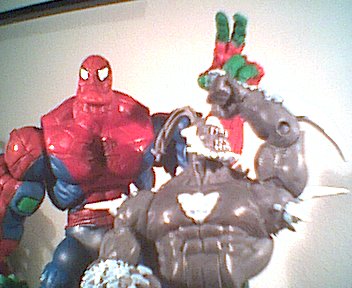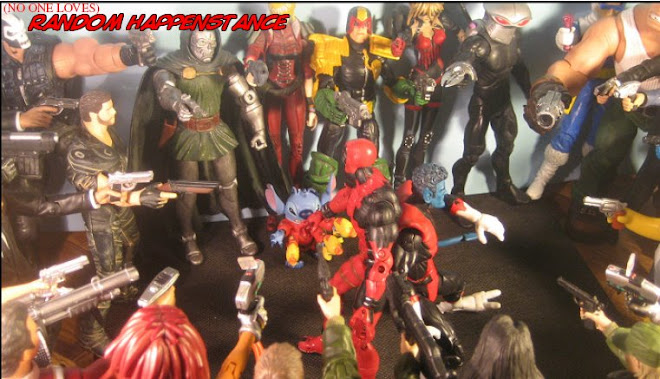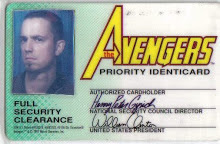
This is...
A. An example of differences in scale between toy lines.
B. Two nice toys, but two characters that should probably never appear in comics again.
C. Comics Code-enforced spandex. Which is probably just as well, really.
D. "When Plot Contrivances Clash!"
Previously, before going off on a rant about God, 06-06-06, and Satan; I mentioned sending my long-suffering wife on a wild goose chase for Vampire Batman, as not seen in stores. After I told her it would be available at the comic shop later in December, she called and had them set one aside for her. (If your comic shop doesn't do this, find another one!) I'm lucky that she did, as I think Vampire Batman sold pretty quickly out of that wave of toys.
Let's try to break this down for the non-toy buyer: say you like chunky peanut butter. Now, let's say your grocery store bought peanut butter the same way many outlets get toys: per case. The case assortment may vary, depending on the relative popularity of chunky. Say out of a case of a dozen, there were 6 plain, 3 chunky, and 2 lowfat. That's only 11, right? Say the last one is the chase--the more rare, hard to find one. Maybe extra chunky. The chase could be something specifically designated as such, or could just be "short-packed."
Ideally, the hardcore fan will buy the plain, chunky, lowfat, and the chase if available. More casual fans may pick up the chunky and the lowfat that are left, and the remaining plain would be picked up by the general man-in-the-street. Using Mattel's recent DC Heroes case, Superman would be plain, Bizarro chunky, Supergirl lowfat, and Doomsday extra chunky. Traditionally, particularly with Mattel, the main hero will be much more prevalent than the villains, and girl action figures will be more rare.
In the real world, things get sticky, and I don't mean Goober Grape. What the hell is that stuff? No, toy speculators, or "scalpers," will often pillage the short-packed, more rare toys. Sometimes, the staff may take "first dibs" on new stock as well. So, to keep our peanut butter example going, you get to the store, and there's 5 plain and 1 lowfat left on the shelf. No chunky for you, until the store orders or puts out a new case. When will that be? Well, that depends. Is it a high traffic item? Will they sell these six peanut butters left, or would a new case be picked the same way, leaving the retailer stuck with ten plain?
The most recent example I can think of for this was Star Wars: Force Battlers. The first assortment was Darth Vader, General Grievous, Obi-Wan, and Anakin. Vader disappeared immediately, and most of the Grievous were soon gone as well, leaving peg after peg of Obi-Wan and Anakin. I never saw them drop in price or go on clearance, so I'm not sure what happened to them all, but they were there for a long stretch.
It's a stereotype to refer to the scalpers as fat, ill-kempt, Comic Book Guy looking bastards. The fact is, it's a business opportunity, and some are making the most of it. For most toys, there are other options. Scalping usually occurs in mass-market outlets like Walmart, so if it's available at a website or comic shop, you have a better chance of requesting an item held for you. Lastly, although most toys will be rare at first and then clogging the shelves a few months later, ebay is always an option. There's also a little more competition on ebay than you would get at a scalper's toy store: even if only four scalpers have put the same toy up for bids, you'll get a better deal there than you possibly could at the scalper's "brick-and-mortar" store where the overhead is higher.


No comments:
Post a Comment